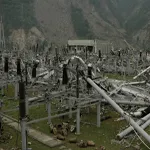
Restoring power to earthquake hit China
Immediately after the devastating earthquake struck China on May 12, the country's State Electricity Regulatory Commission (SERC) activated their highest emergency response systems to respond to the disaster. SERC assured everyone affected that they, and many other Chinese relief agencies, would employ maximum efforts to restore power disrupted by the 7.8 magnitude earthquake that hit China's Sichuan Province. The earthquake severely damaged power facilities in Sichuan, Gansu and Shaanxi Provinces. SERC reported that the massive earthquake, whose epicentre was in Wenchuan County, about 100km from the provincial capital Chengdu, disrupted electricity supply in China's central and north-western regions.
They said that it was too soon to gauge how seriously the grid has been damaged, but the fact that SERC President Wang Xudong activated a Class One emergency response, the highest of five levels, signified the gravity of the situation.
In order to secure power supply, SERC also ordered hydropower plants to monitor dams in quake-hit areas and keep close touch with local governments and flood-control command agencies. Officials at China Huadian Corporation, a centrally-administered power generator, said it had lost contact with its enterprise in the epicentre, although operations in other quake-ravaged regions had resumed shortly after the disaster. Another of the region's major power generators, China Guodian Corporation, reported only temporary interruptions in operations in Sichuan and that a small number of workers injured by stones rolling from a construction site in Daganshan were hospitalized. The company said its hydropower plants in Gongzui and Nanyahe River Valley in Sichuan were operating normally despite strong tremors on the Monday afternoon after the quake.
The State Grid Corporation of China, the country's largest power transmission company serving more than 1 billion people across almost 88 percent of China, reported that the quake had cut the electrical load in Sichuan by 4 million kilowatts, paralyzing one 500-kv power station and five 220-kv power stations. State Grid also said that power plants in western Sichuan including Jiangyou, Jintang, Baozhusi, Maoxian and Dazhou Dongyuan were cut off from the grid.
In Shaanxi Province, the electrical load shrank by 1.5 million kilowatts immediately after the quake with two transformer sub-stations and three power generators malfunctioning or non-operational they said. But the trunk power grid was operating smoothly, and the situation had improved overnight, with the lost electrical load recovering, State Grid reported. To determine the damage to power facilities, a number of emergency response teams from State Grid made their way on foot to the worst-hit regions of Aba in Sichuan and Longan in Gansu, which had been cut off from telecommunications and transportation networks. The State Grid classified railways, telecommunications and hospitals as "crucial users" whose power supply must be secured along with that for residential use to facilities relief work and ease the suffering of the victims.
Weakened dams pose fresh disasters
Shortly after the quake, fears mounted among officials and experts that reservoirs and dams weakened by the earthquake could unleash further disasters on Sichuan province. Two thousand troops were rushed to plug cracks in the Zipingpu dam upriver from the town of Dujiangyan, where half a million people live. The Ministry of Water Resources said that if the Zipingpu dam develops a serious safety problem, it could bring disaster to Dujiangyan.
He Biao, deputy party chief of Aba prefecture, which oversees Wenchuan County, said that if the danger intensifies, this could affect some of the hydro-power stations downstream. The many waterways criss-crossing the mountainous terrain in western Sichuan has proved ideal in the past for hydropower. Eight major dams have been built along the Min River, a Yangtze River tributary that runs through Wenchuan country, the quake's epicentre. The National Development and Reform Commission (NDRC) said that the quake had damaged 391 dams, including two big and 28 medium-sized ones.
Authorities in Chongqing municipality, 400km from the epicentre, reported varying damage to 19 reservoirs and dams, Xinhua said. However, the massive Three Gorges Hydropower Dam, hundreds of kilometres down river from the quakes epicentre, was not affected by the quake, officials said.
Restoring power in Sichuan
A taskforce was soon set-up to oversee the resumption of power supplies to quake-affected areas in Sichuan, where more than 50 towns were still without electricity three weeks after the catastrophic disaster. In Sichuan, which suffered the greatest damage, 32 power plants had stopped supplying the main grid and hundreds of others were cut off from local networks, resulting in an 8.43 million kilowatt loss in electricity output. At the beginning of June, peak supplies in the Sichuan grid were 85 per cent of pre-quake levels, said Yu Yanshan, deputy chief of the General Office under the State Electricity Regulatory Commission. Mr Yu said that Sichuan, which normally exported up to 1.5GW of power each year to other provinces also covered by the Central China Grid, would probably need to import 2GW of electricity after the quake damaged some hydropower dams.
The damaging effects
Whilst it is difficult to gain a full picture it seems that Wenchuan country in Sichuan province, the epicentre of the earthquake which is upstream of the Min River has several hydropower plants in operations, as well as some smaller ones in the tributaries. China's largest power company, China Huaneng Group's Taipingyi hydropower plant is also in Wenchuan country. Although the power plant had no major problems in its dam, the situation of upstream projects was in danger, according to the company.
Apart from hydropower projects, the quake damaged some power equipment manufacturers in Sichuan including Dongfang Electric in Hanwan, Deyan that was badly damaged when several buildings collapsed, causing several hundred deaths.
State Grid Corp of China, which is responsible for the power supply in 26 provinces including Sichuan, said the company was quickening its pace for power system restoration in the earthquake-hit-regions. At present main power grids are stable and the electricity supply was gradually recovering, according to the company.








![Cross Domain [Manu + SBR + ABF + ABR + FMCG + HBR + ]](https://cmg-qa.s3.ap-southeast-1.amazonaws.com/s3fs-public/styles/exclusive_featured_article/public/2025-01/earth-3537401_1920_4.jpg.webp?itok=WaRpTJwE)
![Cross Domain [SBR + ABR]](https://cmg-qa.s3.ap-southeast-1.amazonaws.com/s3fs-public/styles/exclusive_featured_article/public/2025-01/pexels-jahoo-867092-2_1.jpg.webp?itok=o7MUL1oO)









 Advertise
Advertise


